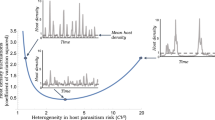Abstract
Many models of parasitic infections lead to an approximately Poisson distribution of parasites among hosts, in stark contrast to the highly over-dispersed distributions that are usually encountered in practice. In this paper, a model is analyzed which, while assuming all individuals to be alike, can still lead to a very heterogeneous distribution of parasites among the host population. The model can be viewed as a very simple mean field interacting particle system, with the particles corresponding to the individual hosts, which behaves like an associated deterministic system when the number of hosts is large. The deterministic system describes the evolution over time of the proportions of the population with different parasite loads, and its equilibria are interpreted as typical distributions of parasites among hosts. Despite its simplicity, the model is complicated enough mathematically to leave a number of open problems.
Similar content being viewed by others
References
Anderson, R. M., May, R. M.: Helminth infections of humans: mathematical models, population dynamics, and control. Adv. Parasitol. 24, 1–101 (1985)
Barbour, A. D.: Asymptotic expansions based on smooth functions in the central limit theorem. Probab. Theory Relat. Fields 72, 289–303 (1986)
Barbour, A. D., Kafetzaki, M.: Modelling the overdispersion of parasite loads. Math. Biosci. 107, 249–253 (1991)
Billingsley, P.: Convergence of probability measures. New York: Wiley, 1968
Born, E., Dietz, K.: Parasite population dynamics within a dynamic host population. Probab. Theory Relat. Fields 83, 67–85 (1989)
Bradley D. J., McCullough, F.: Egg output stability and the epidemiology of Schistosoma haematobium, Parts I and II. Trans. R. Soc. Trop. Med. Hyg. 67, 475–500 (1973)
Cheever, A. W.: A quantitative post-mortem study of schistosomiasis mansoni in man. Am. J. Trop. Med. Hyg. 17, 38–64 (1968)
Foster, F. G.: On the stochastic matrices associated with certain queueing processes. Ann. Math. Stat. 24, 355–360 (1953)
Hadeler, K. P., Dietz, K.: Population dynamics of killing parasites which reproduce in the host. J. Math. Biol. 21, 45–65 (1984)
Kretzschmar, M.: A renewal equation with a birth-death process as a model for parasitic infections. J. Math. Biol. 27, 191–221 (1989)
Kretzschmar, M.: Persistent solutions in a model for parasitic infections. J. Math. Biol. 27, 549–573 (1989)
Leonard, C.: Some epidemic systems are long range interacting particle systems. (Lect. Notes Biomath., vol. 86 pp. 170–183) Berlin Heidelberg New York: Springer 1990
Quinnell, R. J., Medley, G. F., Keymer, A. E.: The regulation of gastrointestinal helminth populations. Proc. Roy. Soc. Lond. Ser. B 330, 191–201 (1990)
Nåsell, I., Hirsch, W.: The transmission dynamics of schistosomiasis. Commun. Pure Appl. Math. 26, 395–453 (1973)
Tweedie, R. L.: Criteria for classifying general Markov chains. Adv. Appl. Probab. 8, 737–771 (1976)
Tweedie, R. L.: The existence of moments for stationary Markov chains. J. Appl. Probab 20, 191–196 (1983)
Author information
Authors and Affiliations
Additional information
This work was supported in part by Schweiz. Nationalfonds Grants Nos 21-25579.88 and 20-31262.91, and by NSF Grant DMS 90-05833
Rights and permissions
About this article
Cite this article
Barbour, A.D., Kafetzaki, M. A host-parasite model yielding heterogeneous parasite loads. J. Math. Biol. 31, 157–176 (1993). https://doi.org/10.1007/BF00171224
Received:
Revised:
Issue Date:
DOI: https://doi.org/10.1007/BF00171224




